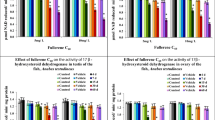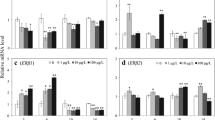Abstract
Quantum dots (QDs) have more and more attention as a novel example of nanocrystals due to their unique fluorescent characteristics. Recently, the toxicity and the potential environmental effects of QDs have become a research hotspot. In this work, in vivo endocrine disrupting effect, toxicokinetics and oxidative stress of QDs were characterized following the intraperitoneal dosing in Chinese loaches. Vitellogenin (Vtg) levels induced by E2 decreased significantly when administrated with the mixture of QDs and E2, which was consistent with the observations of histopathology in testes. The release of free Cd2+ from QDs and the non-specific adsorption of E2 by QDs might be the joint factors contributing to the inhibition of Vtg expression induced by E2 in the male Chinese loaches. In the muscle, bone, intestines, blood and testis, CdSe QDs reached the maximal concentration (C max) in approximately 1-h postinjection and subsequently presented downtrend with the prolonged time. Whereas, there were even increasing tendencies of CdSe QDs’ concentrations in the liver and kidney. It is educible that CdSe QDs can be persistent at least for 7 days, indicating the overall half-life of CdSe QDs in the fish body is very long. The measurement of hepatic superoxide dismutase (SOD) activity and reduced glutathione (GSH) content indicate that QDs have smaller effects on the antioxidative system of the organisms compared with free Cd2+ due to the effective prevention of the release of Cd by PEG coating of QDs. The comprehensive evaluation of QDs’ toxicity in the present study provides an essential and general framework towards more focused research on the elucidation of the biological effects of QDs in vivo.
Similar content being viewed by others
References
Colvin V L. The potential environmental impact of engineered nanomaterials. Nat Biotechnol, 2003, 21(10): 1166–1170
Nel A, Xia T, Mädler L, Li N. Toxic potential of materials at the nanolevel. Science, 2006, 311(5761): 622–627
Dahan M, Levi S, Luccardini C, Rostaing P, Riveau B, Triller A. Diffusion dynamics of glycine receptors revealed by single-quantum dot tracking. Science, 2003, 302(5644): 442–445
Jaiswal J K, Mattoussi H, Mauro J M, Simon S M. Long-term multiple color imaging of live cells using quantum dot bioconjugates. Nat Biotechnol, 2003, 21(1): 47–51
Dubertret B, Skourides P, Norris D J, Noireaux V, Brivanlou A H, Libchaber A. In vivo imaging of quantum dots encapsulated in phospholipid micelles. Science, 2002, 298(5599): 1759–1762
Hardman R. A toxicologic review of quantum dots: Toxicity depends on physicochemical and environmental factors. Environ Health Perspect, 2006, 114(2): 165–172
Shiohara A, Hoshino A, Hanaki K, Suzuki K, Yamamoto K. On the cyto-toxicity caused by quantum dots. Microbiol Immunol, 2004, 48(9): 669–675
Zhang Y B, Chen W, Zhang J, Liu J, Chen G P, Pope C. In vitro and in vivo toxicity of CdTe nanoparticles. J Nanosci Nanotechnol, 2007, 7(2): 497–503
Lovric J, Bazzi H S, Cuie Y, Fortin G R A, Winnik F M, Maysinger D. Differences in subcellular distribution and toxicity of green and red emitting CdTe quantum dots. J Mol Med, 2005, 83(5): 377–385
Selvan S T, Tan T T, Ying J Y. Robust, non-cytotoxic, silica-coated CdSe quantum dots with efficient photoluminescence. Adv Mater, 2005, 17(3): 1620–1625
Kirchner C, Liedl T, Kudera S, Pellegrino T, Javier A M, Gaub H E, Fertig N, Parak W J. Cytotoxicity of colloidal CdSe and CdSe/ZnS nanoparticles. Nano Lett, 2005, 5(2): 331–338
Guo G N, Liu W, Liang J G, He Z K, Xu H B, Yang X L. Probing the cytotoxicity of CdSe quantum dots with surface modification. Material letters, 2007, 61(8–9): 1641–1644
Hoshino A, Fujioka K, Oku T, Suga M, Sasaki Y F, Ohta T, Yasuhara M, Suzuki K, Yamamoto K. Physicochemical properties and cellular toxicity of nanocrystal quantum dots depend on their surface modification. Nano Lett, 2004, 4(11): 2163–2169
Derfus A M, Chan C W, Bhatia S N. Probing the cytotoxicity of semiconductor quantum dots. Nano Lett, 2004, 4(1): 11–18
Tsay J M, Michalet X. New light on quantum dot cytotoxicity. Chem Biol, 2005, 12(11): 1159–1161
Green M, Howman E. Semiconductor quantum dots and free radical induced DNA nicking. Chem Commun, 2005, (1): 121–123
Ipe B I, Lehnig M, Niemeyer C M. On the generation of free radical species from quantum dots. Small, 2005, 1(7): 706–709
Cho S J, Maysinger D, Jain M, Roder B, Hackbarth S, Winnik F M. Long-term exposure to CdTe quantum dots causes functional impairments in live cells. Langmuir, 2007, 23(4): 1974–1980
Stoica A, Katzenellenbogen B S, Martin M B. Activation of estrogen receptor-alpha by the heavy metal cadmium. Mol Endocrinol, 2000, 14(4): 545–553
Martin M B, Reiter R, Pham T, Avellanet Y R, Camara J, Lahm M, Pentecost E, Pratap K, Gilmore B A, Divekar S, Dagata R S, Bull J L, Stoica A. Estrogen-like activity of metals in MCF-7 breast cancer cells. Endocrinol, 2003, 144(6): 2425–2436
Nesatyy V J, Ammann A A, Rutishauser B V, Suter M J F. Effect of cadmium on the interaction of 17 beta-estradiol with the rainbow trout estrogen receptor. Environ Sci Technol, 2006, 40(4): 1358–1363
Olsson P E, Kling P, Petterson C, Silversand C. Interaction of cadmium and estradiol-17β on metallothionein and vitellogenin synthesis in rainbow trout (Oncorhynchus mykiss). Biochem J, 1995, 307(1): 197–203
Hwang U G, Kagawa N, Mugiya Y. Aluminium and cadmium inhibit vitellogenin and its mRNA induction by estradiol-17β in the primary culture of hepatocytes in the rainbow trout Oncorhynchus mykiss. Gen Comp Endocrinol, 2000, 119(1): 69–76
Thomas P. Effects of Aroclor 1254 and cadmium on reproductive endocrine function and ovarian growth in Atlantic croaker. Mar Environ Res, 1989, 28(1–4): 499–503
Gaponik N, Talapin D V, Rogach A L, Hoppe K, Shevchenko E V, Kornowski A, Eychmüller A, Weller H. Thiol-capping of CdTe nanocrystals: An alternative to organometallic synthetic routes. J Phys Chem B, 2002, 106(29): 7177–7185
Bao H B, Gong Y J, Li Z, Gao M Y. Enhancement effect of illumination on the photoluminescence of water-soluble CdTe nanocrystals: Toward highly fluorescent CdTe/CdS core-shell structure. Chem Mater, 2004, 16(20): 3853–3859
Shao J, Shi G Q, Song M Y, Jiang G B. Development and validation of an enzyme-linked immunosorbent assay for vitellogenin in Chinese loach (Misgurnus angaillicaudatus). Environ Int, 2005, 31(5): 763–770
Myung N, Bae Y, Bard A J. Enhancement of the photoluminescence of CdSe nanocrystals dispersed in CHCl3 by oxygen passivation of surface states. Nano Lett, 2003, 3(6): 747–749
Yu K, Zaman B, Singh S, Wang D S, Ripmeester J A. The effect of dispersion media on photoluminescence of colloidal CdSe nanocrystals synthesized from TOP. Chem Mater, 2005, 17(10): 2552–2561
Li C L, Murase N. Surfactant-dependent photoluminescence of CdTe nanocrystals in aqueous solution. Chem Lett, 2005, 34(1): 92–93
Sun Y, Oberley L W, Li Y. A simple method for clinical assay of superoxide dismutase. Clin Chem, 1988, 34(3): 497–500
Ellman G L. Tissue sulfhydryl groups. Arch Biochem Biophys, 1959, 82(1): 70–77
Bradford M. Rapid and sensitive method for the quantification of microgram quantities of protein utilizing the principle of protein-dye binding. Anal Biochem, 1976, 72(1–2): 248–254
Moncaut N, Nostro F L, Maggese M C. Vitellogenin detection in surface mucus of the South American cichlid fish Cichlasoma dimerus (Heckel, 1840) induced by estradiol-17β. Effects on liver and gonads. Aquat Toxicol, 2003, 63(2): 127–137
Hashimoto S, Kurihara R, Strüssmann C A, Yamasaki T, Soyano K, Hara A, Shiraishi H, Morita M. Gonadal histology and serum vitellogenin levels of bigeye tuna Thunnus obesus from the Northern Pacific Ocean-absence of endocrine disruption bio-indicators. Mar Pollut Bull, 2003, 46(4): 459–465
Ballou B, Lagerholm B C, Ernst L A, Bruchez M P, Waggoner A S. Noninvasive imaging of quantum dots in mice. Bioconjug Chem, 2004, 15(1): 79–86
Fischer H C, Liu L C, Pang K S, Chan W C W. Pharmacokinetics of nanoscale quantum dots: In Vivo distribution, sequestration, and clearance in the Rat. Adv Funct Mater, 2007, 16(10): 1299–1305
Yang R H, Chang L W, Wu J P, Tsai M H, Wang H J, Kuo Y C, Yeh T K, Yang C S, Lin P P. Persistent tissue kinetics and redistribution of nanoparticles, quantum dot 705, in mice: ICP-MS quantitative assessment. Environ Health Perspect, 2007, 115(9): 1339–1343
Kappus H. Lipid peroxidation: Mechanisms, analysis, enzymology and biological relevance. In: Sies, H. (Ed.), Oxidative stress. London: Academic Press, 1985. 273–310
Stryer L. Biochemistry, 3rd ed. New York: Freeman W H, 1988
Author information
Authors and Affiliations
Corresponding author
Additional information
Supported by the State High Tech Development (Grant No. 2006AA06Z424), the National Natural Science Foundation of China (Grant No. 20537020), and Chinese Academy of Sciences (Grant No. KZCX2-YW-420-21)
Rights and permissions
About this article
Cite this article
Li, H., Luo, W., Tao, Y. et al. Effects of nanoscale quantum dots in male Chinese loaches (Misgurnus anguillicaudatus): Estrogenic interference action, toxicokinetics and oxidative stress. Sci. China Ser. B-Chem. 52, 1683–1690 (2009). https://doi.org/10.1007/s11426-009-0226-5
Received:
Accepted:
Published:
Issue Date:
DOI: https://doi.org/10.1007/s11426-009-0226-5




